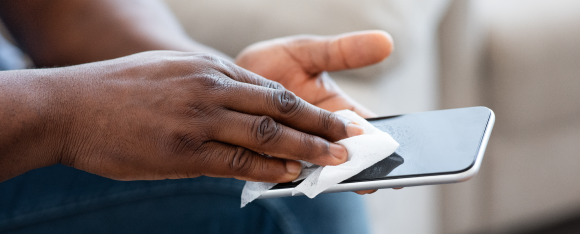The December Oral Wellness newsletter is brought to you by United Concordia,
proud provider of Pennsylvania Farm Bureau dental insurance coverage.

December 2021

‘Tis the season for colds and flu
As we head into those chilly winter months, trying to stay healthy and avoid a cold or flu becomes a challenge. In fact, adults get an average of two to three colds every year, and worse, recovery can take anywhere from seven to ten days.
A few other things you can do this season to stay healthy are:
- Wash your hands to reduce germ spread, as well respiratory illnesses by 16%-21% (see article below for information on germy surfaces)
- Stay home if you feel sick or have symptoms of a cold or flu (sneezing, runny nose, fever, sore throat)
- Eat healthy, reduce stress, and get adequate sleep
- Consider getting a flu vaccine, as the Centers for Disease Control says an annual flu vaccine is the best way for individuals to protect themselves from falling ill with a strain of influenza.[1]
- Brush your teeth twice and floss at least once daily to minimize bacteria in your mouth
Save the sugar and alcohol for celebrating
If you find yourself feeling lousy in spite of taking these precautions, you may turn to an over-the-counter cough or cold medicine. Although these remedies can help with symptoms, the downside is that most of them, particularly liquid cold medicine and cough syrup/drops, contain sugar in the form of high fructose corn syrup and sucrose. This might make them taste better, but combined with the already-present, harmful bacteria in the mouth that feed off sugar, it can harm your teeth and gums.
Plus, cold medicine often includes citric acid, which eats away tooth enamel, making it even easier to develop problems like cavities or infections. To reduce this risk, rinse your mouth with water or brush your teeth after taking liquid cold medicine. Or better yet—choose a brand that’s sugar-free or opt for pill-form medication.
Dry mouth can harm your teeth
Reduced saliva production increases the risk of cavities and other oral health problems. Some medicines contain alcohol, which can dry out your mouth. People often take antihistamines to decrease excess fluid or mucus production typical with a common cold, but this also reduces saliva flow. If you don’t have enough saliva in your mouth, it’s more difficult to wash away sugar and germs and neutralize acids. Plus, when your gums and cheeks get too dry, they can become irritated and inflamed, making it easier for bacteria to breed and cause issues like gum disease.
Some alternative treatments for that stuffy nose or sore throat are drinking herbal tea or hot water with lemon or taking a steamy shower or bath, or try out a Neti pot to irrigate the nasal area. Tea and water can also help improve dry mouth, as well as chewing sugar-free gum or lozenges. To boost your immune system, take Vitamin C, Vitamin B6, Vitamin E or zinc.[2]

7 Surprisingly germy surfaces
By now, we all know to wash our hands for 20 seconds and apply hand sanitizer to protect ourselves from germs.
But even after you disinfect your digits, touching some of these filthy familiar items can undo that diligent cleansing. Given the fact that we touch our faces on average 23 times an hour[3], new germs can get transferred from your fingers and hands to your eyes, mouth and nose – and make you sick.
Ready to be creeped out? Here’s a list of everyday items you’ll want to keep squeaky clean.
- Your cell phone
Would you put your face up against a toilet bowl? That’s basically what you’re doing when you make a call. Because research shows your cell phone is 10 times dirtier than the seat![4] So use a headset or go hands-free. And keep that puppy clean. Wiping the phone with a microfiber cloth removes most germs. For a deeper clean, mix 3 parts water to 2 parts rubbing alcohol. Dampen a cloth with the solution, then wipe down the entire phone. - Restaurant menus
Just think how many hands have opened that menu before you. Studies show that E. coli and staph are often present on the surface – especially on the plastic ones.[5] So make sure to wash your hands after ordering, or rub with sanitizer before you eat. - The kitchen sponge
According to the National Sanitation Foundation, more than 75% of dish sponges have Salmonella, E. colie and fecal matter.[6] To kill bacteria, heat damp sponges in the microwave for a minute, or soak them in a quart of warm water with ½ tsp. concentrated bleach. And, just like you replace your toothbrush, get a new sponge every week or two. - Bathroom towels
Towels that hang in dark, damp bathrooms – near the toilet! – offer prime real estate for bacteria growth. One study showed that 90% were contaminated after a few days of use.[7] Wash towels in hot water about every two days. And since regular detergent won’t kill all bacteria, use one that contains activated oxygen bleach. - Microwave handle
Almost 50% of microwave handles have such high bacteria levels, they’re considered high risk for spreading illnesses.[8] Spray the door, handle and touch pad with glass cleaner and wipe dry with a paper towel. Or rub surfaces down with a disinfecting wipe. - Makeup applicators
Every time you touch your mascara wand, blush brush or eyeshadow sponge, they pick up germs from your hands. Swiping dirty tools near your eyes, nose and mouth can lead to breakouts, pink eye and fungal infections.[9] So wash beauty tools after every use. Squeeze out sponges with bar soap and hot water, and wash brushes with gentle dish soap or baby shampoo. - Inside the washer
Warm, wet laundry that’s not promptly thrown in the dryer can start to get germy. If your clothes sit for more than 30 minutes, wash them a second time. And when it comes to water temperature, the hotter the better to kill bacteria and viruses. Heading to the laundromat? Wipe out the washer drum with a disinfecting wipe first.

Toothache? It might be a sinus infection
Sure, toothaches can be caused by true dental problems, such as cavities, abscesses or broken teeth. But that sharp, throbbing pain could also be a symptom of a sinus infection, or sinusitis. Especially if only the top teeth hurt.
Sinus cavities are basically air pockets inside our heads. There are two in our forehead and larger ones in each cheek. Sinuses make a gooey mucus, which keeps inside our nose moist, plus traps dust and dirt. Mucus naturally drains into our throat, and we swallow it.
With a sinus infection, your sinus cavities become inflamed. Swelling in the cheek sinuses can put pressure on nerves of your top back teeth, which are right nearby.[10]
If you press hard on the tooth that hurts and don’t have an immediate pain, or if the tooth is not sensitive to hot or cold, it might not be a dental issue. Other symptoms of sinus infection include:[11]
- Stuffy or runny nose
- Face pain or pressure
- Cough or congestion
- Bad breath
- Fever
If you suspect a sinus infection, make an appointment to see your doctor. Treatments can include a course of antibiotics for more serious cases, or decongestants, saline nasal washes and other home remedies for milder cases. And if you believe it’s a toothache, see your dentist.
Give the Gift of a SMILE
Holley Kirkland, RDH, Oral Wellness Consultant, United Concordia Dental
One of the kindest and healthiest gifts you can give this holiday season is a SMILE! 😊
It costs you nothing but has value beyond measure. Did you know that the act of smiling not only lifts your mood, but it has positive effects on your overall health? Did you know smiling can:
- Lower your blood pressure
- Increase your endurance
- Reduce pain
- Reduce stress
- Strengthen your immune system
When you smile, your brain releases tiny molecules called neuropeptides that fight off stress, and in this mix you also get other neurotransmitters like dopamine, serotonin and endorphins, which act as mild pain relievers and reduce stress and depression.
Smiling also has a domino effect, so your smile positively affects those around you! When you smile at someone, it is very hard for that person to not smile back and react in kind. This activates your brain and makes you feel better, too.
So, if you are still looking for that PERFECT gift … and you see someone without a smile, give them one of yours.
United Concordia Dental is proud to be an integral partner in keeping your smile healthy and ready to share.
Sugar-free Keto Gingerbread Cookies
So, what’s the skinny on “keto”? It’s a low-carb diet that centers on eating healthy fats from foods like avocados, nuts, salmon, Greek yogurt and eggs.
Very simply, when your body is deprived of carbohydrates, it goes into a metabolic state called “ketosis”. When this happens, you start burning fat for energy.
But you don’t have to be eating keto to enjoy these soft, chewy cookies. This yummy recipe replaces white flour with almond flour and uses a sweetener called brown monk fruit rather than table sugar. They’re extra-delish when iced with sugar-free cream cheese frosting!
Ingredients:
2 ¼ c. blanched almond flour
1 tbsp. cinnamon
1 ½ tsp. ground ginger
¼ tsp. ground cloves
¼ tsp. nutmeg
½ tsp. baking powder
⅛ tsp. sea salt
½ c. golden or brown monk fruit sweeter
3 tbsp. butter, softened
1 tsp. vanilla extract
Directions:
In a medium bowl, stir together the almond flour, cinnamon, ground ginger, ground cloves, nutmeg and baking powder.
In a large bowl, use a hand mixer to beat the butter and brown monk fruit sweetener for 1-2 minutes until fluffy. Next beat in the egg and vanilla extract. Then beat in the almond flour mixture until a dough forms.
Form the dough into a ball and refrigerate for at least 30 minutes or until ready to bake.
Preheat the oven to 350° F. Line a cookie sheet with parchment paper. (You may need to do this twice.)
Place the ball of dough between two large pieces of parchment paper. Roll out to ¼-inch thickness. Use cookie cutters to cut out cookie shapes and transfer them to the baking sheet. When you’ve cut all the shapes you can, re-form the remaining dough into a ball, roll it out again and repeat until you’ve used it up.
Bake for 10-15 minutes until edges are golden. Cool on the baking sheet before handling or frosting.
If you want to pipe your cookies, make keto cream cheese frosting by first beating 4 oz. of softened cream cheese with 2 tbsp. soft butter. Next beat in ½ cup of powdered allulose sweetener and 1 tsp. of vanilla extract. Lastly, beat in 1 tbsp. of heavy cream (or more, if needed) until frosting is of piping consistency.
Recipe courtesy of Wholesome Yum
1. cdc.gov; 2020-2021 Flu season summary; October 2021.
2. health.clevelandclinic.org; Vitamins that are best for boosting your immunity, January 2020.
3. Forbes.com; You’ll be surprised how often you actually touch your face; July 2020.
4. Time.com; Your cell phone is 10 times dirtier than a toilet seat. Here’s what to do about it; August 23, 2017.
5. Journal of Food: Microbiology, Safety & Hygiene: “Pathogen Persistence in Restaurant Menus: Comparison Between Materials”; January 2016.
6. thehealthy.com This is how often you should replace your kitchen sponge, And what happens when you don’t; May 2020.
7. time.com; Your towels are way dirtier than you think; September 2017.
8. cookinglight.com; You’re probably not cleaning this filthy surface – and you really should be; December 2018.
9. Bustle.com; This will convince you to wash your makeup brushes; February 2016.
10. Mayoclinic.org; Sinus infection and toothache: Any connection?; September 2021.
11. Webmd.com; What is sinusitis?; July 2020.
12. online.uwa.edu; Psychology to grin about: The benefits of smiling and laughter; March 2020.
Stay Connected. Stay Healthy. |


